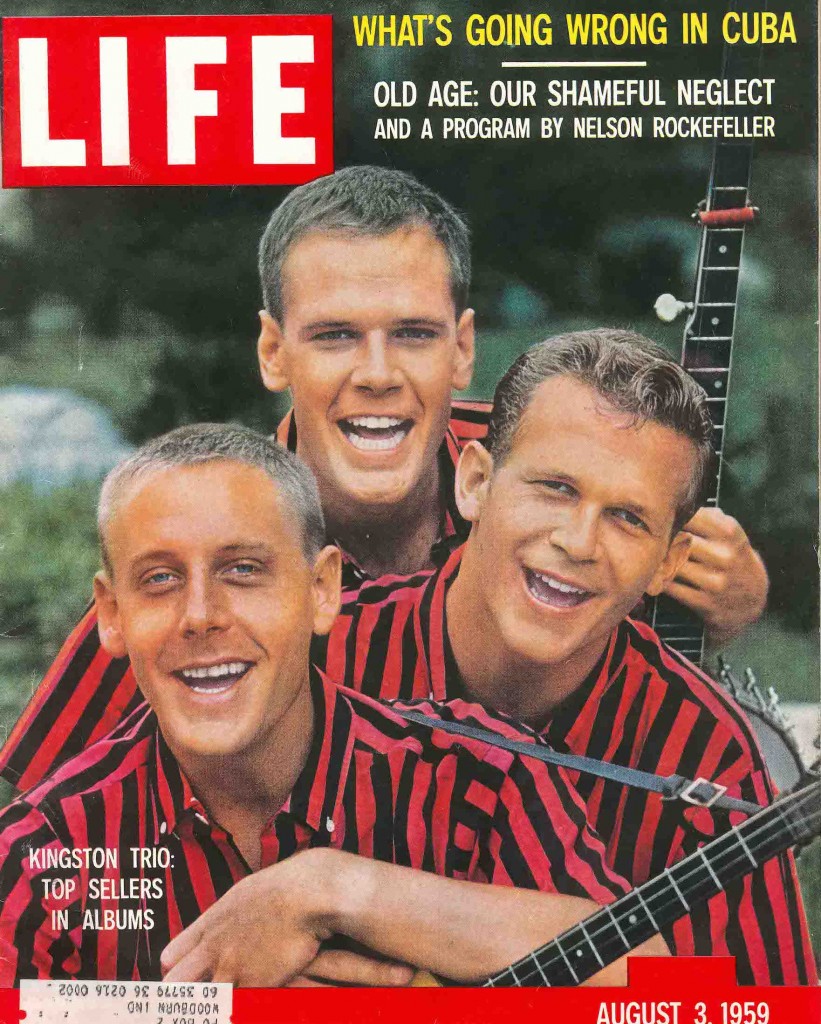Archive for April, 2015
April 30th, 2015 by dave dorsey
 More about this excellent book by Matthew Crawford later, a great follow-up to his first, but couldn’t resist putting this out there, while I’m reading it:
More about this excellent book by Matthew Crawford later, a great follow-up to his first, but couldn’t resist putting this out there, while I’m reading it:
“But consider that when you go deep into some particular skill or art, it trains your powers of concentration and perception. You become more discerning about the objects you are dealing with and, if all goes well, begin to care viscerally about quality, because you have been initiated into an ethic of caring about what you are doing. Usually this happens by the example of some particular person, a mentor, who exemplifies that spirit of craftsmanship. You hear disgust in his voice, or see pleasure on his face, in response to some detail that would be literally invisible to someone not initiated. In this way, judgment develops alongside emotional involvement, unified in what Polanyi calls personal knowledge. Technical training in such a setting, though narrow in its immediate application, may be understood as part of education in the broadest sense: intellectual and moral formation.”
–Matthew Crawford, The World Beyond Your Head
I think he means ethical formation in the sense of ethos, but I own’t argue.
April 28th, 2015 by dave dorsey
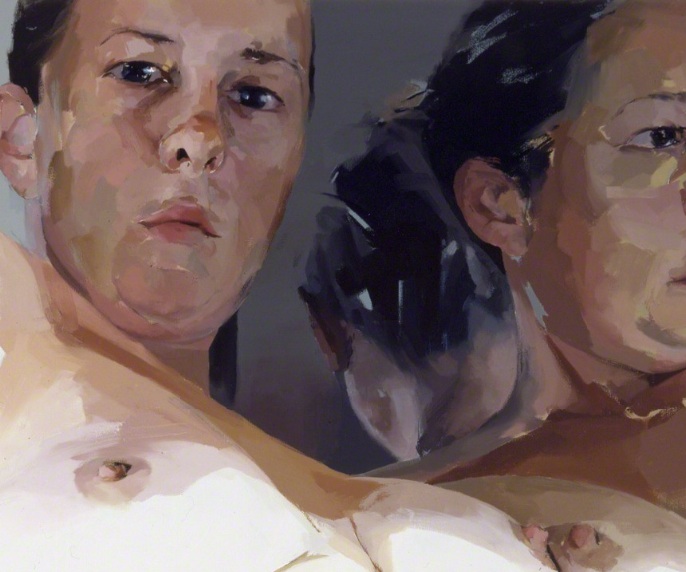
Saville is one of my favorite painters, even though I don’t much enjoy looking at her work. I don’t think I could say this about any other painter. I’m always amazed at how she handles paint, though her subject matter and scale strike me as calculated and contrived. Her choice of grotesque imagery reminds me of Freud and Bacon, dutiful in its lurid depictions of human flesh, with an emphasis on paint for paint’s sake. With all of them, the point seems to be: we’re all just meat. OK, got it. Now what?
In this detail of a nude that appears to be a self-portrait, she’s squatting and exposing her crotch to a camera, having enclosed herself in mirrors that reflect various parts of her body. The way she translates the tones in her face is so masterful and abbreviated and soothingly pleasant–she summarizes areas of color so effectively and, it seems, effortlessly, and in this picture she’s breathing, just waiting to go do something less awkward. She’s thinking, How long do I have to subject myself to this? Those who know Adobe software will recognize qualities in the image that inspire admiration rather than dismissal of the technology, assuming it was involved. If not, all the more impressive. The colors are subtle and beautiful, in and of themselves, and they convey the beauty of her face, even while the full image is as arresting and flagrant as porn, which allows her to situate a lovely face in a painting outre enough to maintain critical respect. It’s a head fake. See what I’ve got? Made you flinch by shoving myself at you. Don’t worry, I won’t use it on you. Whew. It would be great to see her apply this same facility to commonplace things and people, rather than rely on the spectacle of unappealing bodies and body parts to get people to stop and not look away. So, I love this painting, despite itself. You can see it here.
April 25th, 2015 by dave dorsey
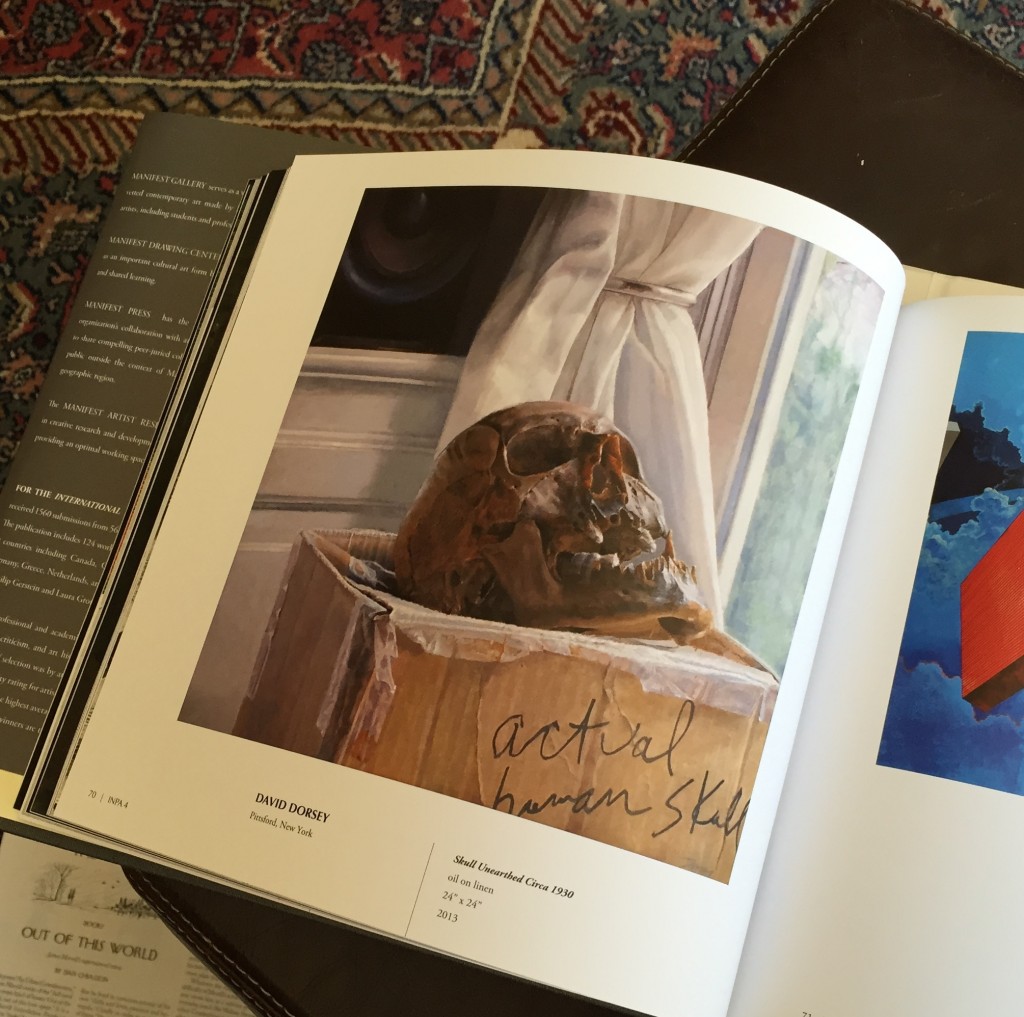
Manifest International Painting Annual 4
My copies of the Manifest INPA 4 arrived today, and when I saw the three boxes containing them I realized I went overboard while ordering and now own three hardbound and four softbound copies of the International Painting Annual. I’m lucky and honored to have had two paintings picked for inclusion in the book, which may be the finest collection of work I’ve seen in any Manifest publication. There’s a special emphasis on the human figure in this one, and it’s quietly rousing to see bodies and faces, as well 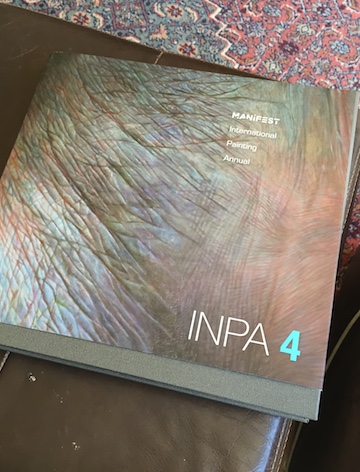 as the human skull I contributed, rendered in so many different ways, filtered through so many different perspectives and sensibilities. It’s a humbling, but consistently thrilling, experience to leaf through the book slowly and take in so much amazing work. The competition picks three winners–an astonishingly talented Erin Wozniak first and foremost with her comparatively tiny, simple and yet utterly alive figurative painting. The rest of us are presented as finalists–a nice way of singling out the three most remarkable artists and yet still offering ample recognition for the 92 others picked for the book, selected from 1560 entries by 563 artists from 32 different countries. This year, I’ve failed to get into the first four shows I’ve entered, which is how it goes some years, so the book arrived as a nice reminder that recognition is a cyclical phenomenon, coming and going on its own schedule, to its own rhythms. I’m going to post quite a few of my favorite paintings from the book over the next few weeks, with some brief comments. It’s great to read, up front, how Manifest is still gathering momentum, expanding its exhibition space and its programs, offering more and more opportunities for solo and group shows, simultaneously. If you want to see what people are doing with paint right now around the world, order a copy from Manifest. It’s well worth the price.
as the human skull I contributed, rendered in so many different ways, filtered through so many different perspectives and sensibilities. It’s a humbling, but consistently thrilling, experience to leaf through the book slowly and take in so much amazing work. The competition picks three winners–an astonishingly talented Erin Wozniak first and foremost with her comparatively tiny, simple and yet utterly alive figurative painting. The rest of us are presented as finalists–a nice way of singling out the three most remarkable artists and yet still offering ample recognition for the 92 others picked for the book, selected from 1560 entries by 563 artists from 32 different countries. This year, I’ve failed to get into the first four shows I’ve entered, which is how it goes some years, so the book arrived as a nice reminder that recognition is a cyclical phenomenon, coming and going on its own schedule, to its own rhythms. I’m going to post quite a few of my favorite paintings from the book over the next few weeks, with some brief comments. It’s great to read, up front, how Manifest is still gathering momentum, expanding its exhibition space and its programs, offering more and more opportunities for solo and group shows, simultaneously. If you want to see what people are doing with paint right now around the world, order a copy from Manifest. It’s well worth the price.
April 16th, 2015 by dave dorsey
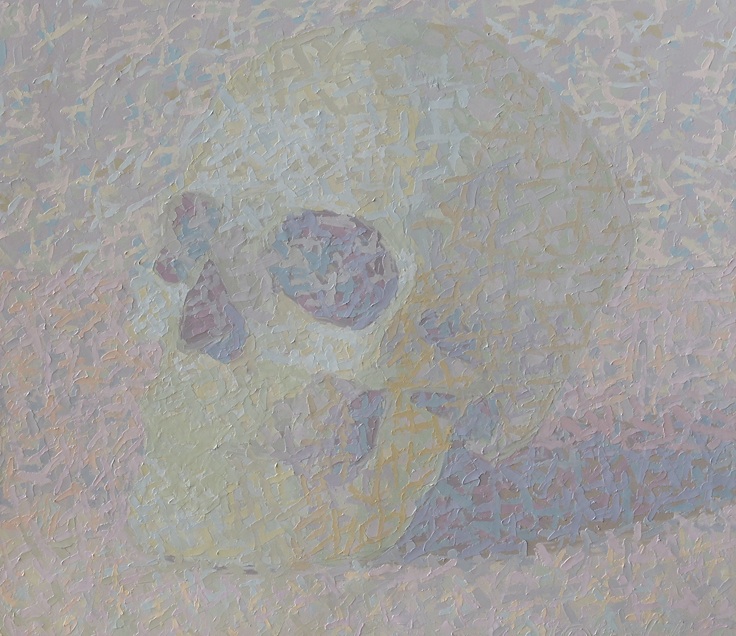
A Study of a Human Skull, David Oleski
At our recent lunch, Rick Harrington reminded me of David Oleski’s work, and I returned to it, at his website, with pleasure. It’s gotten more subtle and complex in execution, and yet in a way even simpler in its effect, than when I looked a few years ago. It’s a remarkable way to start with Impressionism, especially Monet and Seurat, and somehow also evoke work from a century, as well, finding a home that somehow seems to link Mark Tobey with Morandi. I dread most greens, but he appears to have devoted countless hours to finding new ways to see that color. I like how his areas of color seem to sit quietly and stay where they are, without any sense that one area of paint is moving toward another, no hint of gesture, as if a realistic image of a pear has settled into simpler patterns, all the details disappearing like sediment into a map of peach, green, yellow, and ochre. It’s a mystery how he breaks up what he sees into the cross-hatches he’s trying now. His statement, below, suggests that he contends with something I’ve encountered–that many potential collectors see his work as decorative, since it’s beautiful and devoid of metaphoric content. It’s all perceptual, but that doesn’t mean it isn’t an attempt to give vision a resonance that evokes something like wisdom and joy. It would look great in a room, but that doesn’t mean it’s decor. I like, in his statement, he talks so much about craft and materials.
I came to the realization that many people don’t really understand what MORE
April 14th, 2015 by dave dorsey
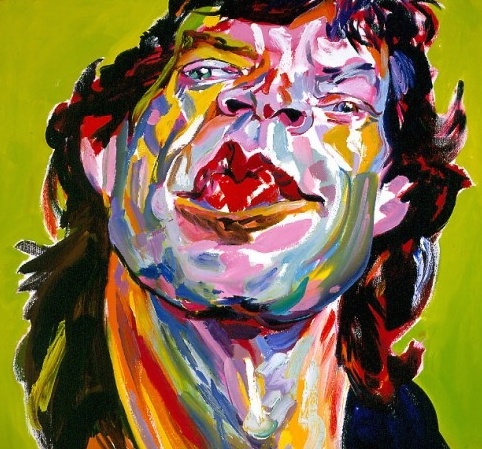
Philip Burke’s Jagger
Can’t wait to see this just an hour’s drive away. From ArtVoice:
A few weeks prior to his exhibit entitled The Likeness of Being: Portraits by Philip Burke, which opens on Friday (4/10) at the Burchfield Penney Art Center, Burke met with Artvoice at the office of L.B. Madison Fine Art near his home in Niagara Falls, NY, where much of the work for the upcoming show was being gathered in preparation for display at the gallery.
Moving quickly around a small, sunny room crowded with canvases stacked several deep against the walls, it’s clear that Burke is enthusiastic about his upcoming exhibit—the largest of his career. He points out some early works of Ronald Reagan and Margaret Thatcher, commissioned for Vanity Fair magazine when it resumed publishing in 1983. The works are smaller—maybe 2 feet by 3 feet—done on cardboard canvasses. “You can see I was poor,” he laughs, “Not that I’m rich now.”
April 12th, 2015 by dave dorsey
 From Manifest, check out the impressive prize this year for what has to be the most exacting art competition anywhere. Time to get to work:
From Manifest, check out the impressive prize this year for what has to be the most exacting art competition anywhere. Time to get to work:
The 6th Annual MANIFEST PRIZE
$5000 award + solo feature exhibit of the winning work
Open to works of any media, any genre/style, any size…
We are very excited to announce that the annual Manifest Prize (ONE) award is increasing to $5,000. This underscores our non-profit organization’s strong desire to reward, showcase, celebrate, and document the most exceptional artwork being made today, and to do this in a non-commercial public context. Further, it is to incentivize the creation of excellent art. Manifest’s mission is centered on championing the importance of quality in visual art. This project is one aspect of the realization of that mission.
The entry process for the 6th annual Manifest Prize award (ONE 6) is now open.
There are no restrictions on submissions to The Manifest Prize. Artists who have been included in previous Manifest projects are always welcome to submit to any future project, including the Manifest Prize.
MEDIA: Open to any and all traditional and non-traditional visual arts media.
Submission deadline: October 1, 2015
For complete info visit: http://www.manifestgallery.org/one
April 10th, 2015 by dave dorsey
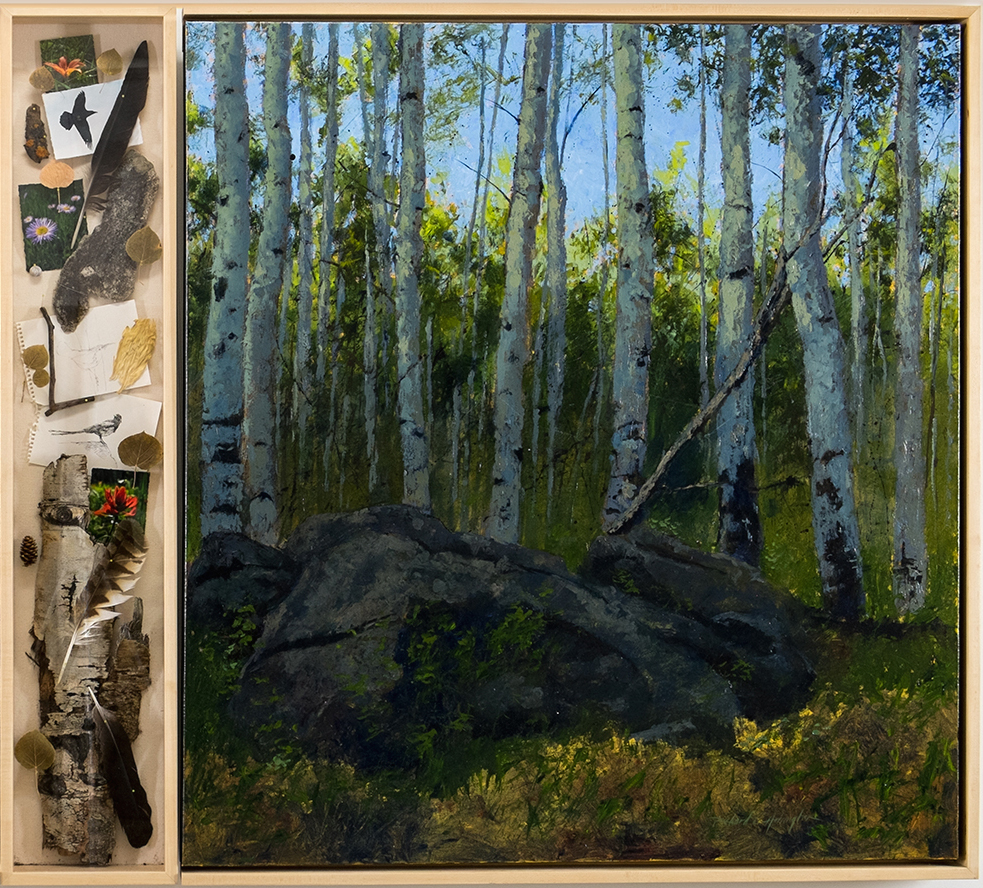
Kebler Pass, detail, with curio cabinet
A show of Rick Harrington’s paintings opened a few days ago at the Vilona Gallery in Boulder, Colorado. Rick, and his son Todd, met me at the Gatehouse for lunch last week, followed by an hour-long tour of the Memorial Art Gallery. As a road warrior, Rick is my hero. He has logged many thousands and thousands of miles, tens of thousands probably, driving his work to juried fairs around the country. He works hard and then plays hard, too, fly fishing or whitewater kayaking somewhere within a drive of his shows out West and elsewhere. His painting and his immersion in these recreational ventures into the wild are two sides of one activity for him. Someone clever might be able to make the case that they may simply be one activity viewed from two different points in time. He says the process of exploring and interacting with nature, as a prelude to the painting, immerses him in the world, while en plein air painting makes him more of a static observer. His most ambitious work so far has been a series of large, quasi-abstract landscape paintings attached to windowed boxes full of natural artifacts he has collected from the particular place depicted in the painting. (It reminds me of Burchfield’s quirky, obsessive attempt to depict sounds and other non-visual sensations in his paintings, all in the hope of triggering a deeper identification with nature in the viewer). For the past sixteen years, Rick has relied exclusively on his painting for income. His wife, Darby, is a college administrator and a writer, and her steadier income has balanced the ups and downs of Rick’s. Since 2008, the battle has been tougher, but he’s still making it work.
We talked about the shows I’d seen in New York City, and Todd agreed that Donatello was not only one of the greatest sculptors in history, but also one of our favorite Ninja Turtles. Rick can be hard to hear MORE
April 8th, 2015 by dave dorsey
Some people say I’m a no-count
Others say I’m no good
But I’m just a natural born travellin’ man
Doin’ what I think I should, oh yeah
Doin’ what I think I should
And I don’t give a damn about a Greenback a-dollar
Spend it fast as I can
For a wailing song and a good guitar . . .
The only things that I understand, poor boy
The only things that I understand.
When I was a little baby
My momma said, “Hey son
Travel where you will and grow to be a man
And sing what must be sung, poor boy
Sing what must be sung.”
–Kingston Trio
April 6th, 2015 by dave dorsey
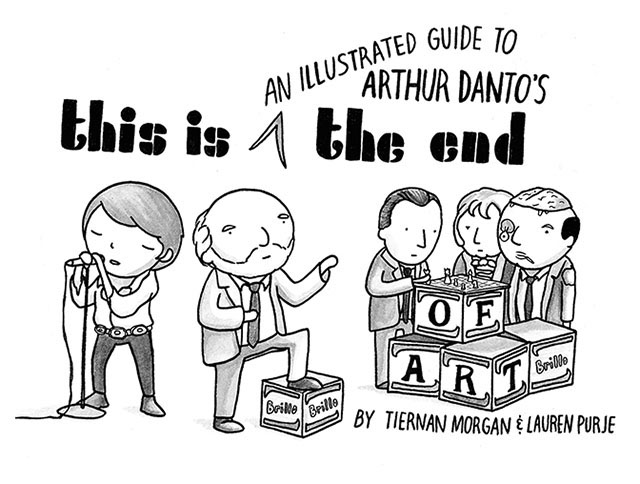 This piece from Hyperallergic is a great, accurate overview of Arthur Danto’s singular contribution to art philosophy. Reading After The End of Art was a liberating and crucial experience for me, though his conclusions at the end of the book were dispiriting. Essentially he asserted that, in the Sixties, art arrived at the end of the long history of its struggle toward greater and greater creative freedom. In that decade, and ever since, it was established that anything could be designated as a work of art, and therefore an artist could literally do anything as a means of expression. Everything was, and is, permitted, to echo Dostoevsky’s phrase, in a different context.
This piece from Hyperallergic is a great, accurate overview of Arthur Danto’s singular contribution to art philosophy. Reading After The End of Art was a liberating and crucial experience for me, though his conclusions at the end of the book were dispiriting. Essentially he asserted that, in the Sixties, art arrived at the end of the long history of its struggle toward greater and greater creative freedom. In that decade, and ever since, it was established that anything could be designated as a work of art, and therefore an artist could literally do anything as a means of expression. Everything was, and is, permitted, to echo Dostoevsky’s phrase, in a different context.
The question then becomes, why create art at all? If the need to push art “forward” toward something historically new is no longer possible, then why make art? Danto’s answer was that each individual has to answer that question, one person at a time, and that the answer to the question is baked into the artwork just as a philosophy of life is embedded in a person’s daily actions. Each individual has to explore and understand why he is creating something, in utter freedom–there is no obligation to do anything in any particular way. The work must justify itself, without relying on an historical context: no more schools of art to advocate one way of doing things over many others. (Danto’s point was that whatever virtues one way of doing things has over another, it isn’t because it’s fresher or more “contemporary” or new in the traditional sense or somehow an historical advance over what has come before.) His key insight was that Pop Art was the art movement to end all art movements, liberating all individual artists to do whatever they wished, and think for themselves, as individuals.
Whether Pop Art holds up now as something that’s still interesting, MORE
April 4th, 2015 by dave dorsey
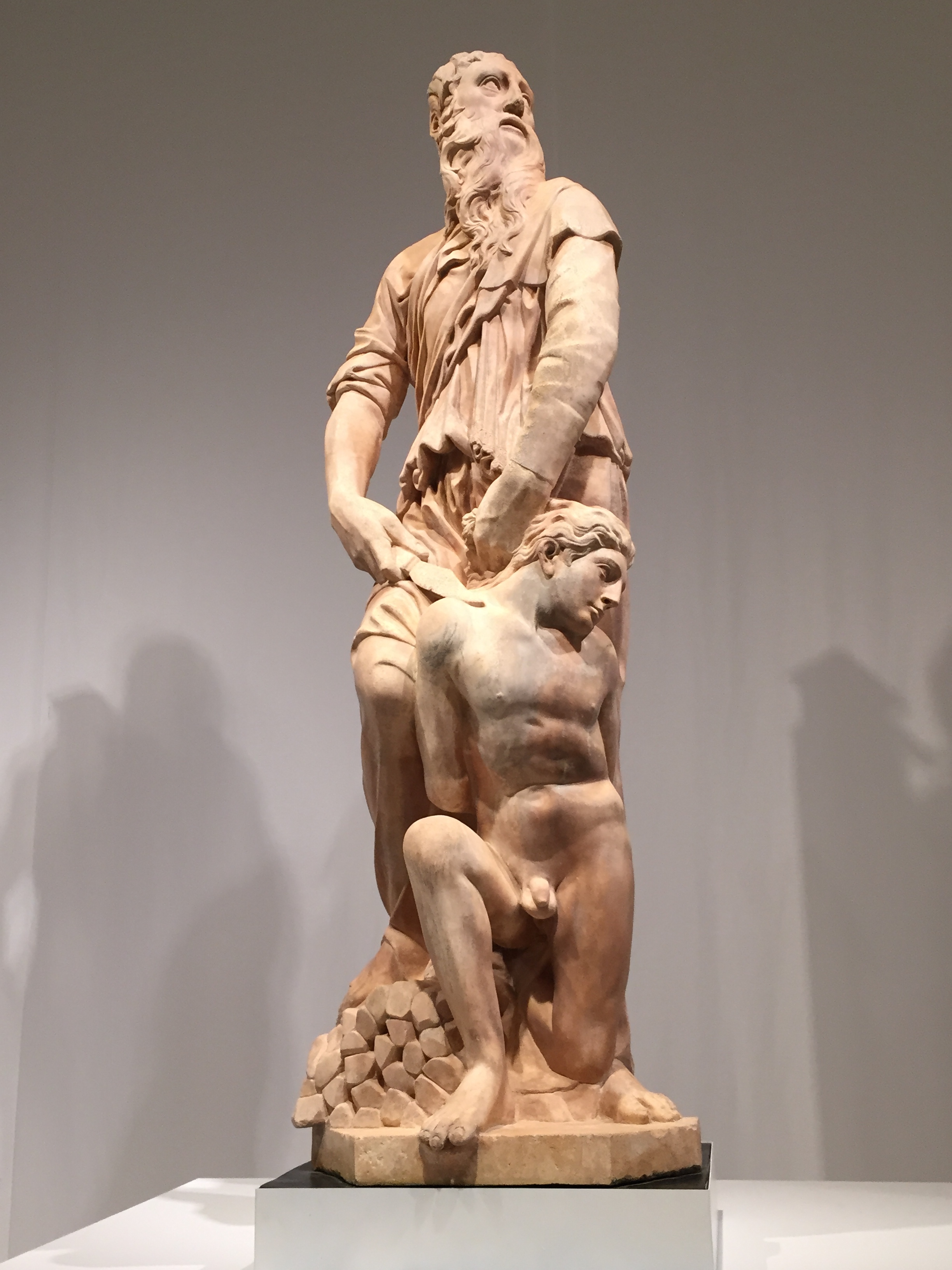
The Sacrifice of Issac, Donatello
On my last, too-short visit to New York City, I was lucky enough to see the astonishing Sculpture in the Age of Donatello at a museum I didn’t know existed until a couple days before my trip: the Museum of Biblical Art, near Columbus Circle. Two works in the show were so powerful that for me they fused together two qualities Edmund Burke tried hard to keep apart: the beautiful and the sublime. For him, beauty was evoked by an art of balance and order, subtlety and color. He called sublime whatever inspired awe or dread or even terror. In his own time, he would have considered Turner an artist of the sublime, with Constable working the field of beauty. Now a couple weeks after finding myself gazing speechless while looking at Donatello’s rendering of Abraham and Isaac, and his almost modernist Prophet, it struck me that the quattrocento sculptor found a way to make beauty indistinguishable from anguish, dread and spiritual abandonment. These two sculptures are humbling visions of two individuals struggling with a sense of complete alienation and loss: not simply loss in the sense of being bereft of everything others enjoy, but a spiritual losing of one’s way. These are two figures who have cut themselves adrift from every mooring, trusting only an inner imperative, even if it leads toward what nearly anyone else would consider madness.
One can think of how this works in the world’s wisdom traditions, MORE
April 2nd, 2015 by dave dorsey
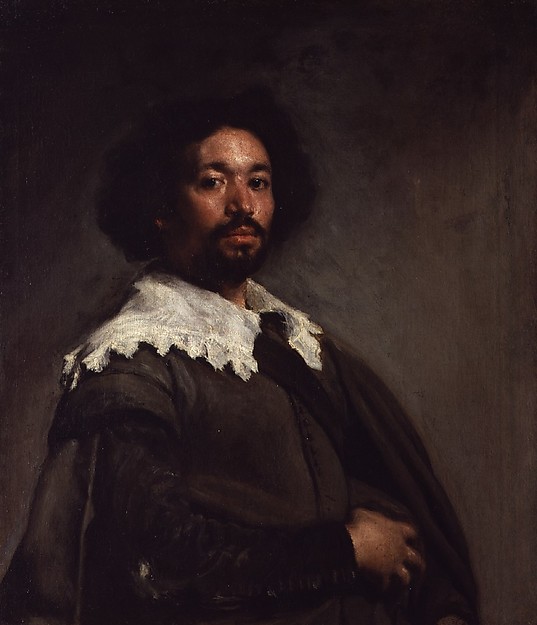
Juan de Pareja, Velasquez, Metropolitan Museum of Art
I spent Monday last week mostly wandering around the Metropolitan, re-visiting paintings I’d seen before and seeing a few things I hadn’t, including the murals of Thomas Hart Benton and an exhibit about Native American art, yet the work that made the deepest impression on me was this portrait. I’d seen it on visits before but I really spent some time with it. The quality of his paint is incomparable, and every time I see one of his paintings I understand why he had such a powerful influence over painters as diverse as Manet, Bacon and Fairfield Porter. Yet in this one, it isn’t just beautifully painted; the quality of life is uncanny. From the Metropolitan website:
An Appreciation of the Portrait THEODORE ROUSSEAU Vice-Director, Curator in Chief
The Metropolitan Museum paid an enormous sum to acquire the portrait of Juan de Pareja by Velazquez. The decision to buy the picture was made because it is one of the finest works of art to come on the market in our time. It is among the most beautiful, most living portraits ever painted. Velazquez, whose works are extremely rare, ranks with the greatest painters. This is precisely the kind of object which the Museum has a historic duty to acquire. An unusual thing about this picture is that we know what people thought about it when it was painted. The information comes to us from a Flemish artist, Andreas Schmidt, who was in Rome in 1650 when Velazquez painted it. Schmidt later went to Madrid, where he told the story to Antonio Palomino y Velasco, the historian of Spanish art, who published it some sixty five years later. Palomino tells us that when Velazquez was in Rome, where he had been sent to buy pictures for his master, the king of Spain, he painted the portrait of the pope, Innocent X. In order to practice before beginning his sittings with this supremely important personage, he did a portrait from life of his assistant, the young mulatto painter Juan de Pareja. This was so startling a likeness that when he sent Pareja to show it to some of his friends, it had a sensational effect upon them. They were literally astounded by it, and reacted with a mixture of “admiration and amazement” (the Spanish word asombro implies fright, mixed with surprise and admiration) “not knowing as they looked at the portrait and its model whom to address or where the answer would come from.” The portrait was then shown in an exhibition of outstanding pictures both old and new in the Pantheon, “where it was generally applauded by all the painters from different countries who said about this portrait everything else looked like painting, this alone like reality”.
April 1st, 2015 by dave dorsey

Monument, oil on panel, 25″ x 27″
How many roads you’ve traveled/How many dreams you’ve chased/Across sand and sky and gravel/Looking for one safe place. —Marc Cohn
I spent a couple hours with Matthew Cornell shortly after his opening at Arcadia, talking with him about his work, and it was nearly as rewarding as the hour it allowed me to spend just looking at his exceptionally personal and accomplished paintings. I got there early and had already spent a quarter hour moving from painting to painting, amazed at the way he can evoke unsentimental feeling from images of ordinary, nondescript middle class streets. His work is photo-realistic, but he softens it almost imperceptibly to a dreamlike quality that, for me, hovers between day and night, waking and sleep, memory and immediate sensation. In one painting after another, you feel slightly like a child racing through the dusk from far away, late for dinner, finally catching sight of home. You look at his images and think, “This is America, and this is where I want to be, if I could only get back inside this house.” I’d seen examples of his smaller paintings before at Arcadia, and most of them are modestly scaled, but Pilgrimage, a series of scenes depicting the houses where he and his family lived over the past half century, gathers individual paintings into a larger context that offers a respectful, loving celebration of middle America, haunted by loss but full of quiet, patient vitality. It’s as if he’s nostalgic for a quality of life that has only gone into hiding, biding its time, waiting to re-emerge. Most of the work was already sold, two days after the opening, and that fact—paired with the impeccable quality of the paintings—buoyed me with a sense of hope that simple, direct, and genuine painting, full of love for its subject, without relying on cleverness or pretension, can find a market even in New York City, at prices that reflect the actual value of the work.
Matthew met me at the gallery, only hours before he was to fly back to Florida. He turned out to be tall, good-looking, with a youthful manner for someone who recently turned 50. He was layered up against historic cold temperatures here in the Northeast that must have felt especially bitter after flying to Manhattan with his wife, Rachel, from Orlando, where they live. He told me he undertook this project, in earnest, after both of his parents died a little more than a year ago. We wasted no time and started getting to know one another immediately by talking shop. We began at home plate, as it were: with an oil of the house where he lives with Rachel now, a modest Cape Cod, with a studio in a separate structure at the back of the driveway, and a chain-link fence around the front yard. As with almost all the other paintings, Cornell  captured this home at dusk, late dusk, and the twilight both deepened the color and enabled him to stint effectively on much of the detail that might have been unavoidable in full daylight. Yet the chain link fence looked perfect, as if he had woven it from spider web. The lack of light intensified the beauty of the scene—at noon, it would have faded into a dreary, hard-edged matter-of-factness so typical of photo-realism.
captured this home at dusk, late dusk, and the twilight both deepened the color and enabled him to stint effectively on much of the detail that might have been unavoidable in full daylight. Yet the chain link fence looked perfect, as if he had woven it from spider web. The lack of light intensified the beauty of the scene—at noon, it would have faded into a dreary, hard-edged matter-of-factness so typical of photo-realism.
“That’s our house. We live there. My studio is lit up slightly in the back,” he said.
“The fence is incredible.”
MORE
 More about this excellent book by Matthew Crawford later, a great follow-up to his first, but couldn’t resist putting this out there, while I’m reading it:
More about this excellent book by Matthew Crawford later, a great follow-up to his first, but couldn’t resist putting this out there, while I’m reading it:






